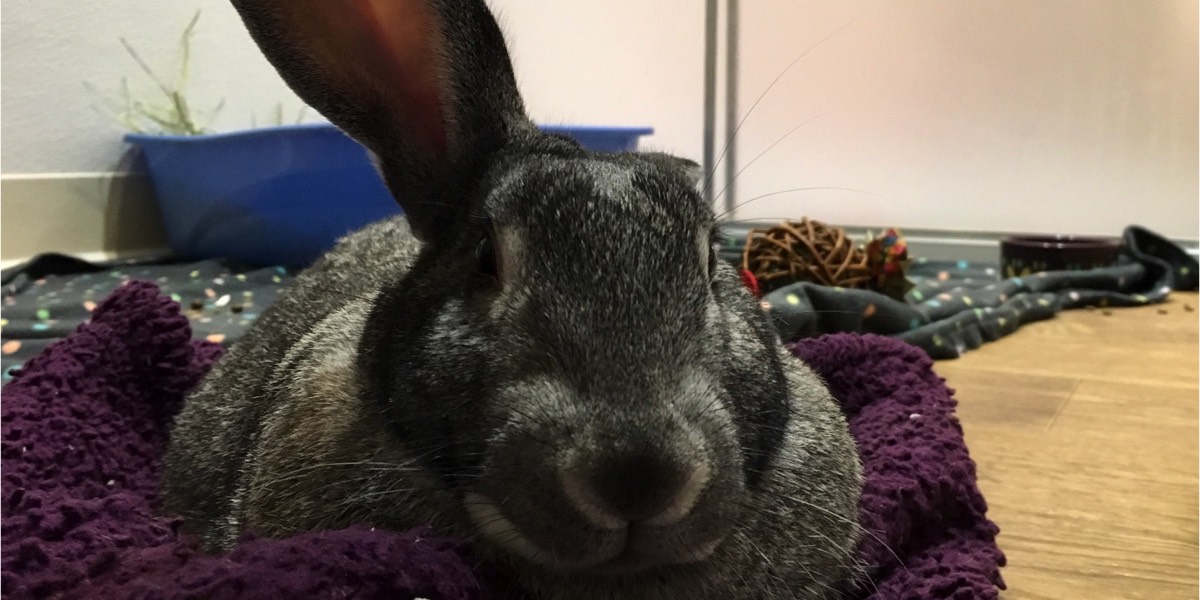
Clicker Training for Rabbits
Adapted with permission from "Training Shelter Rabbits" by Bob Betts.
Clicker training is a very effective method used to train many different kinds of animals, including rabbits. It uses a small device, called a clicker, which makes a consistent sound. At first we teach our bunny to want to hear the click. How? We bribe him with his favorite thing, food. Once he learns to want the click, we can use it to teach him a behavior or skill.
At the instant he does a behavior that we want, we click, and then treat as soon as possible. Bunnies realize very quickly that a certain specific behavior, marked by a click, is getting him a treat. When the skill has been learned, we give it a name by adding a voice command, a hand cue or a combination of both. As he recognizes the voice command and/or hand signal, we fade the clicker, using it less and less for each skill. Treats must always be given, at least occasionally.
At the instant he does a behavior that we want, we click, and then treat as soon as possible. Bunnies realize very quickly that a certain specific behavior, marked by a click, is getting him a treat. When the skill has been learned, we give it a name by adding a voice command, a hand cue or a combination of both. As he recognizes the voice command and/or hand signal, we fade the clicker, using it less and less for each skill. Treats must always be given, at least occasionally.
Getting Started
Bunnies are prey animals and can frighten easily, so the first clicks should be done with the clicker in a pocket, under a shirt, behind the back, or otherwise muffled. Initially it is easiest to begin with a type of food as the reward. You can use pellets, pieces of bunny cookies, or a favorite green as the reward. Try to choose healthy rewards to avoid giving your bunny too much sugar.
At first a click will be meaningless to “Thumper”, so he needs to learn that a click means something good is about to happen. At first you can click every time that you feed him or give him any treat. Soon he will associate the click with the food reward.
Once this association is established, you can wait for your bunny to do a desired behavior. As soon as he does it, click. The clicker is used to mark the instant that he does the desired behavior, signaling that the bunny will get his treat. Remember that bunnies must never be pushed to do a behavior. It must be “his idea” to do a behavior. To get the rabbit to do what you want you can use imagination and take advantage of his natural inclinations. For example rabbits often will stand on their hind legs to get a good look around. That can be used to get them to stand up. Click the instant he stands on his hind legs, then treat.
Precise timing is important. If you miss the moment and you click too late or too early, you must still treat. If he does the desired behavior and you miss it, it is better to not click at all than to click late.
At first a click will be meaningless to “Thumper”, so he needs to learn that a click means something good is about to happen. At first you can click every time that you feed him or give him any treat. Soon he will associate the click with the food reward.
Once this association is established, you can wait for your bunny to do a desired behavior. As soon as he does it, click. The clicker is used to mark the instant that he does the desired behavior, signaling that the bunny will get his treat. Remember that bunnies must never be pushed to do a behavior. It must be “his idea” to do a behavior. To get the rabbit to do what you want you can use imagination and take advantage of his natural inclinations. For example rabbits often will stand on their hind legs to get a good look around. That can be used to get them to stand up. Click the instant he stands on his hind legs, then treat.
Precise timing is important. If you miss the moment and you click too late or too early, you must still treat. If he does the desired behavior and you miss it, it is better to not click at all than to click late.
Clicker Training Basic Steps
- Get the rabbit to do the behavior you want.
- Click the instant he does it.
- Reward the rabbit with a treat he loves and praise.
- AFTER he reliably does the trick, add a cue (voice or hand command) so the rabbit knows the name or signal for the behavior you want him to do.
- Over time, slowly phase out the clicker and treats so he will do the action purely on command. Never phase out the treats entirely. Always treat sometimes; otherwise he may quit the behavior.
Adding the Cue
- Give the cue just as the rabbit begins to do the behavior: cue at behavior, then click and treat.
- Give the cue a bit earlier, just before he does the trick. From this point on only click and treat if the bunny does the behavior after being cued. Do not click and treat if he offers the behavior without being asked.
- Finally do the cue at any time to ask for the behavior. Not just when he was about to offer the behavior.
- When your bunny gets tired stop and give him a treat for all his hard work.
What Can You Teach? Ideas for Clicker Training
Targeting:
- Hold the target stick in one hand and treats in the other.
- Remember that bunnies cannot see directly in front of them so hold the target stick near “Thumper’s” head, but a bit to one side. Be careful not to hit “Thumper’s” nose with the target.
- Eventually “Thumper” will become curious and touch it with his nose. The instant he touches it, click then treat.
- You should find now that if you move the target around, “Thumper” will chase after it and touch it with his nose. Click and treat when he does.
- Since a target is not used as a trick in itself you should not add a voice command. Voice commands are used with the behaviors that you teach using the target, such as “Spin”.
Stand Up:
- Hold the target (or a treat) over “Thumper’s” head. Do not say anything at all. Hold the target and clicker in one hand and the treat in the other hand. Be ready to click.
- When he stands on his hind legs to investigate, click the clicker and give the treat. Timing is vital. Be sure to click at the instant he stands on hind legs. Resist the urge to add any voice command – use ONLY the clicker.
- Repeat this for about 10 times or until “Thumper” is standing up reliably.
- If you are luring, switch hands and hold the clicker, instead of the treat, above “Thumper’s” head and have a handful of treats in the other hand. When he rises to the clicker, click and when he drops back down to all four feet, treat.
- Continue doing this until “Thumper” reliably comes up to the clicker.
- When the behavior is firmly fixed to the click you can add the voice command “Stand up.” When he stands up, click and treat.
- Wean from the clicker by using the voice command and when he stands click every other time and treat.
- Continue this routine, varying so the click happens less and less frequently as he starts responding to the voice command. Still treat every time. You should also add praise as he learns.
- Start making the treat intermittent. Treat sometimes but other times don’t treat. Continue to tell him what a great bunny he is.
Clicker Training Resources:
Clicker Training Examples:
Triangle Rabbits is an all-volunteer 501(c)(3) nonprofit organization serving North Carolina, U.S.A.

